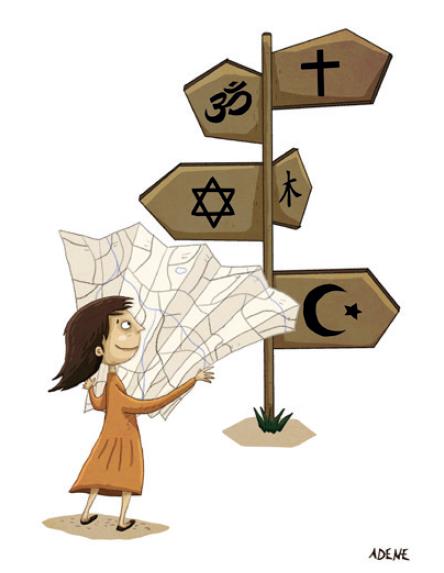Module 2: Inclusive interaction
#Faith4Rights toolkit
Full text of commitment II
| We see the present declaration on “Faith for Rights” as a common minimum standard for believers (whether theistic, non-theistic, atheistic or other), based on our conviction that interpretations of religion or belief should add to the level of protection of human dignity that human-made laws provide for. |
Context
Perceptions about religions are often negative in the human rights sphere and vice versa. The mainstream view, in both disciplines, seems to conceive them in a competition mode: one is divine while the other is human-made. In addition, the human rights environment is projected as secular and liberal. Religions, in the general stereotype, are rather associated with conservatism. Historical tragedies in the name of religion, political populism and doctrinal secularism have aggravated controversies and tensions. Reconciling religions and rights is the gist of this module. An adapted narrative to achieve such reconciliation is possible, based on the shared goals and grounds of both disciplines. The 18 commitments on “Faith for Rights” provide common minimum standards in this respect. These commitments have been agreed upon by experts with different types of convictions and are offered as a platform for joint and individual action among all believers, whether theistic, non-theistic, atheistic or other. Freedom of conscience applies to all of them. The heart of module 2 is the all-encompassing definition of religion or belief.
Additional supporting documents
In support of the peer-to-peer learning on commitment II, the training file should include UN Human Rights Committee General Comment No. 22 of 1993 as it elaborates important elements of the definition of religion or belief, which is fundamental for faith actors to discuss. The terms “belief” and “religion” are to be broadly construed and human rights protection is not limited to followers of traditional religions or of beliefs with institutional characteristics or practices analogous to those of traditional religions. A similarly broad definition was offered by Arcot Krishnaswami, Special Rapporteur of the Subcommission on Prevention of Discrimination and Protection of Minorities, in his 1960 study: “the term ‘religion or belief’ is used in this study to include, in addition to various theistic creeds, such other beliefs as agnosticism, free thought, atheism and rationalism.”
Additional resources for commitment II are the Declaration on Faith in Human Rights of 2008, and the Document on Human Fraternity for world peace and living together, signed by Pope Francis and the Grand Imam of Al-Azhar in February 2019 (the President of the World Jewish Congress, Ronald S. Lauder, reiterated in November 2019 his endorsement of the basic principles outlined in the Abu Dhabi Declaration on Human Fraternity). The reason is that commitment II projects a fundamental shift from each religious group defending its own community (against others) into the notion of a “community of believers” that defends the rights of all faith communities. This “togetherness” is at the heart of the “Faith for Rights” framework, as captured at the outset in commitment II.
A key message to be conveyed by the facilitators, when justifying the need for these additional resources, is to indicate the growing importance attributed to the roles of faith actors in societies both at the national and international levels. The common message expressed by these additional documents is that faith actors come together and send a unifying message of solidarity with each other and defence of human dignity for all. United Nations Secretary-General António Guterres stressed in this context: “I firmly believe in the power of faith leaders to shape our world for good. […] Again and again, I have been struck by the consonance of key precepts and core values between the different faiths. Indeed faith is central to hope and resilience.”
As always, nothing precludes facilitators from adding national and even local documents in the same vein. Indeed, they are encouraged to do so. Presenting the content of the additional documents thus becomes in itself an updating tool and part of the learning exercise. The more local, national and regional documents are used as additional resources, the better it is to enhance national ownership, bottom-up generation of knowledge and contextual relevance.
Peer-to-peer learning exercises
Unpacking: Participants may break down commitment II into different elements. The same methodological guidance as that related to commitment I is relevant. Applied to commitment II, the unpacking can focus on two important notions: togetherness, or community of believers regardless of variations of their beliefs, as well as the most fundamental issue of the human interpretation of divine texts. When unpacking a complex issue like interpretation of religious texts, a stimulating question by facilitators could include: Should human interpretation of religion vary in time and space? Why? How?
Critical thinking: A critical discussion of the relationship between elements of commitment II would help participants navigate fundamental issues that are rarely addressed in a multidisciplinary manner. Participants could be asked, for example, if they disagree with the human rights law definition of “religion” and “belief”. Using the positioning exercise, facilitators could ask the participants to stand up and position themselves along one side of the room, with the left corner representing “I agree with the definition” and the right corner “I don’t agree”; they can also position themselves somewhere in the middle.
In the following discussion, the facilitator could ask participants if they see a contradiction between theology and law in this respect. Or is it just a divergence of scopes that do not have to be identical? Is such a divergence reconcilable? This point is critical for the full acceptance of equal rights and non-discrimination on any ground. If faith actors are not genuinely convinced of the absolute nature of the freedom of conscience and the corresponding equal worth of and respect for all believers, there is little chance they would stand up for the rights of others and react in solidarity when believers from different faith tradition are denied their religious freedom or other human rights.
Contextualization should be a methodological priority for facilitators all along their management of the peer-to-peer learning sessions. They are encouraged to reiterate questions such as: What does this commitment mean in practice? How does it relate to your local context? Who owes what to whom? How can this commitment be implemented? How do you see your own role in implementing this commitment? What do you intend to change and how? Such questions are particularly valid for commitment II, where joint action to remedy infringements on human dignity in the name of religion is at the heart of the matter.
The facilitator could also refer to the 2013 report, in which Special Rapporteur on freedom of religion or belief Heiner Bielefeldt stated: “Unfortunately,the idea that freedom of religion or belief and equality between men and women represent essentially contradictory human rights norms seems to be widespread and has even gained currency in parts of the larger human rights community. As a result, possible synergies between freedom of religion or belief and equality between men and women remain underexplored. Even worse, existing human rights work in this field is sometimes openly discouraged or delegitimized. Moreover, an abstractly antagonistic construction of the two human rights norms cannot do justice to the needs, wishes, experiences and specific vulnerabilities of many millions of women whose life situations falls within the intersection of discrimination on the grounds of their religion or belief and discrimination on the ground of their sex or gender. This problem disproportionately affects women from religious minorities.”
Tweeting: Participants individually summarize this commitment in less than 140 characters. Participants can then select the tweets that are best formulated. This exercise is meant for de-constructing the commitment and reenergising the discussions. One possible result of this tweeting exercise could be as follows: “We commit to use the declaration on ‘Faith for Rights’ as a common minimum standard of interaction between theistic, non-theistic, atheistic or other believers”.
Translating: Similar to the tweeting exercise, participants could be asked to “translate” this commitment into child-friendly language or into a local dialect. Again the idea is to sharpen the reflex of focusing on its most important elements while simplifying the message, without losing the substance of the commitment.
Storytelling: The facilitator could introduce this exercise as aimed at sharing experiences both “face-to-face” and “faith-to-faith”. Participants may provide an example of a situation where they had to deal with the broad understanding of theistic, non-theistic, atheistic or other believers and how they handled such situations (collective exercise for 15 minutes). In this context, the facilitator could also refer to the following example raised by Special Rapporteur on freedom of religion or belief Ahmed Shaheed in his 2019 report: “Avijit Roy, an American-Bangladeshi blogger, was visiting Bangladesh when he and his wife, Rafida Ahmed, were attacked by persons with machetes in the streets of Dhaka. Although his wife recovered from injuries sustained in the brutal attack, Roy died shortly after he was taken to hospital. His murder was part of a growing trend of violent attacks against bloggers and atheists, which intensified in the period 2013–2016, during which at least 10 bloggers and publishers were attacked and killed. Amidst rising demands for a law to make blasphemy a capital crime, the Government responded by stating that such a law was not necessary since the existing legislation prohibited gratuitously offensive attacks on religion. In 2013, the Government set up a committee to track bloggers and others making derogatory statements online about Islam. Subsequently, a list of the names of 84 bloggers who wrote on religion, reportedly compiled by an extremist group, was made public.”
Adding faith quotes: Participants are requested to add new religious or belief quotes in support of commitment II (individual exercise for five minutes, followed by a reading by each participant of his or her added reference).
Exploring: Could the additional religious or belief-based quotes gathered through the preceding exercise be used in religious preaching on issues related to this commitment, namely dialogue, religious and cultural diversity and the equal rights of non-believers? How?

 Inspiring: As in all modules, participants conclude them with an artistic expression from their own cultural sphere that captures aspects of the commitment under discussion. Facilitators can submit their own examples, including the cartoon and calligraphy depicted here as well as music.
Inspiring: As in all modules, participants conclude them with an artistic expression from their own cultural sphere that captures aspects of the commitment under discussion. Facilitators can submit their own examples, including the cartoon and calligraphy depicted here as well as music.
Learning objectives
- Participants realize that religions and human rights share the ultimate goal of safeguarding human dignity. They should therefore be mutually reinforcing.
- Participants recognize that their beliefs are an essential source of human rights, which are indivisible because in real life each human right relies on other rights.
- Participants integrate this paradigm into their preaching and activities in a manner adapted to their own convictions.
- Participants appreciated the value of acting on an inter-faith basis for enhancing cohesive societies and meaningful engagement among faith communities.
previous module ¦ overview ¦ next module >